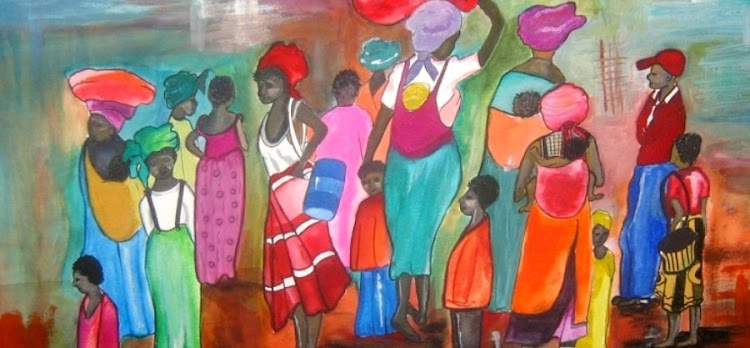 The Leopard is the most secretive of all the African big cats. This elusive behavior probably makes it the most cunning of the big cats.
The Leopard is the most secretive of all the African big cats. This elusive behavior probably makes it the most cunning of the big cats.
Leopards are solitary nocturnal hunters preying on anything from fish to birds, monkeys, baboons and antelope. The natural enemies of Leopards are Lions and Hyena's who often attempt to steal their kill.
This forces the leopard to haul its larger prey up into a tree where it can feed in relative safety. So pound for pound this makes it the strongest climber of the cats, able to bring down prey much larger than itself and haul it to safety high up in the trees.
The spots on Leopards are called "rosettes" which can be irregular shaped circles or squares depending on the area they inhabit. The East African Leopards in general have circular rosettes while the Southern African leopards have square ones.
Their coats can also vary from a light fawn colour in dry warm areas to a darker shades in thick forest areas. The spots create an almost perfect camouflage for their habitat.
 Cheetah's are considered the fastest animals on earth can reach speeds of up 110 km an hour within a few seconds.
Cheetah's are considered the fastest animals on earth can reach speeds of up 110 km an hour within a few seconds.Unlike Leopards they live in well structured social groups. They hunt their prey by stalking to within 10 to 20 meters before setting off on the chase. The chase only lasts from 20 seconds to a minute with only about fifty percent of their efforts being rewarded with a kill.
Their kill is often stolen from them by larger predators like lions, leopards and hyena. They generally feed on small antelope, young animals and birds.
Cheetah's can be distinguished from the other big cats by their long slender bodies and small heads with distinctive tear lines that run from the corner of their eyes to the side of their nose.
Cheetah's have been kept in captivity for more than 5000 years but do not breed well in captivity with numbers being maintained by capturing wild ones. New cheetah's born in captivity generally die within a month of birth
The cheetah population has declined over the years and are only found in about 25 African countries and about 100 in Iran. They suffer from lack of diversity in their gene pool and this had an effect on their breeding, Cheetah cubs also become prey to the larger carnivore's and ninety percent die within 3 months in the wild.
There are estimated to be 12 to 15,000 remaining in the wild with the biggest threat to their numbers being dwindling habitat, shooting and trapping as they are considered livestock predators.
These two oils were painted by Debbie Thom my daughter, whom I will be featuring occasionally as a guest artist on my site.
This brings me to the question. "Are artists born artistic? or is it a skill that can be learned by non artistic people? Whilst I have no doubt even a born artist can learn new skills to improve their techniques and interpretation. I cannot help but wonder if all the famous artists were born with specific genes that make them artists.
The reason I ask the question is simply because like me Debbie has had no formal education in art and to my knowledge has never had an art lesson in her life. Art has always been a hobby for her and she is quite content to be a mother and housewife who paints in her spare time.
This leads me to believe that certain artistic skills are inherited, as my mother used to do drawings when she was young and this must be where my sister and I inherited our skills. I also have a cousin who is an art teacher in Australia.
It would be interesting to know if any genetic studies have been done to determine if there are specific artistic genes that are passed on from one generation to another.
Maybe the word art is too broad a term as there are many different forms of art and I have no doubt many of the art forms can be taught to anyone with the inclination to learn them. So my question will be specifically about painters and sculptors rather than the arts in general. That does not mean I only consider painters and sculptors true artists.
My next task though is to try and persuade Debbie to put her god given talent to more use and take her art more seriously. I think together we can start our own gallery or collaborate in some way.
I would hate her to one day and have regrets as I did, I did not use my talent earlier in my life. I have also learned though not to interfere in my kids lives as they have their own ideas and will ultimately make their own decisions without any influence from me.
Their kill is often stolen from them by larger predators like lions, leopards and hyena. They generally feed on small antelope, young animals and birds.
Cheetah's can be distinguished from the other big cats by their long slender bodies and small heads with distinctive tear lines that run from the corner of their eyes to the side of their nose.
Cheetah's have been kept in captivity for more than 5000 years but do not breed well in captivity with numbers being maintained by capturing wild ones. New cheetah's born in captivity generally die within a month of birth
The cheetah population has declined over the years and are only found in about 25 African countries and about 100 in Iran. They suffer from lack of diversity in their gene pool and this had an effect on their breeding, Cheetah cubs also become prey to the larger carnivore's and ninety percent die within 3 months in the wild.
There are estimated to be 12 to 15,000 remaining in the wild with the biggest threat to their numbers being dwindling habitat, shooting and trapping as they are considered livestock predators.
These two oils were painted by Debbie Thom my daughter, whom I will be featuring occasionally as a guest artist on my site.
This brings me to the question. "Are artists born artistic? or is it a skill that can be learned by non artistic people? Whilst I have no doubt even a born artist can learn new skills to improve their techniques and interpretation. I cannot help but wonder if all the famous artists were born with specific genes that make them artists.
The reason I ask the question is simply because like me Debbie has had no formal education in art and to my knowledge has never had an art lesson in her life. Art has always been a hobby for her and she is quite content to be a mother and housewife who paints in her spare time.
This leads me to believe that certain artistic skills are inherited, as my mother used to do drawings when she was young and this must be where my sister and I inherited our skills. I also have a cousin who is an art teacher in Australia.
It would be interesting to know if any genetic studies have been done to determine if there are specific artistic genes that are passed on from one generation to another.
Maybe the word art is too broad a term as there are many different forms of art and I have no doubt many of the art forms can be taught to anyone with the inclination to learn them. So my question will be specifically about painters and sculptors rather than the arts in general. That does not mean I only consider painters and sculptors true artists.
My next task though is to try and persuade Debbie to put her god given talent to more use and take her art more seriously. I think together we can start our own gallery or collaborate in some way.
I would hate her to one day and have regrets as I did, I did not use my talent earlier in my life. I have also learned though not to interfere in my kids lives as they have their own ideas and will ultimately make their own decisions without any influence from me.










